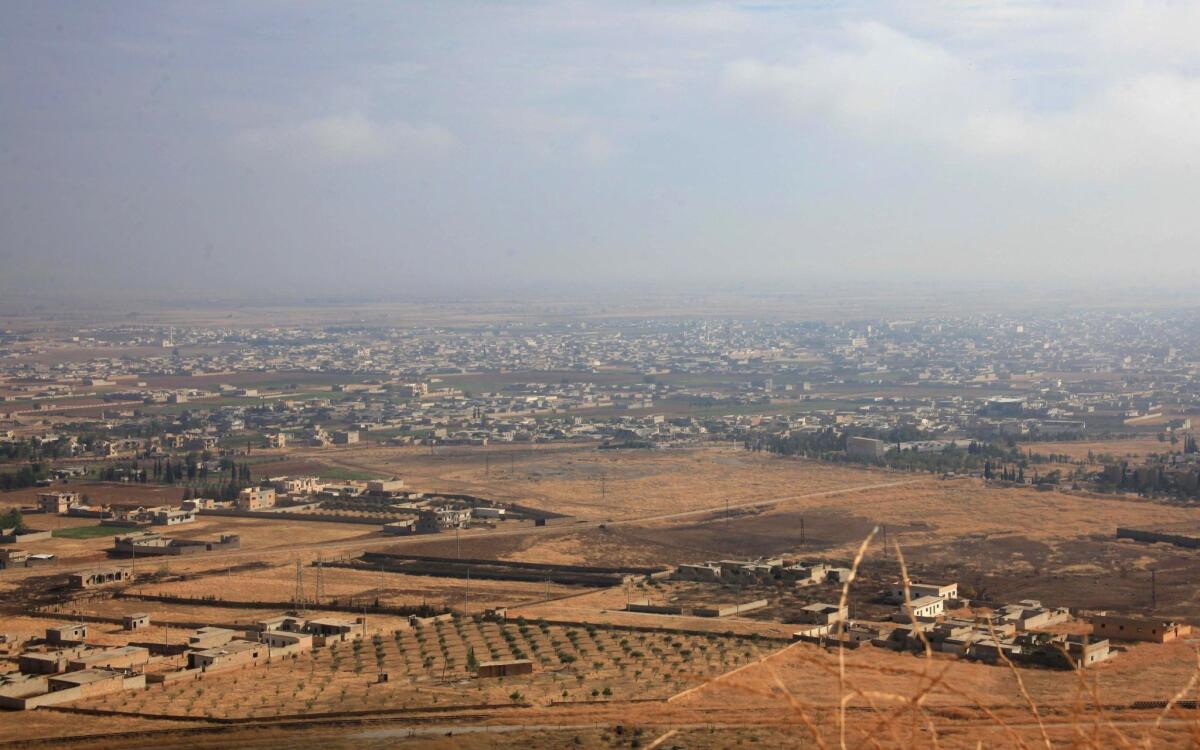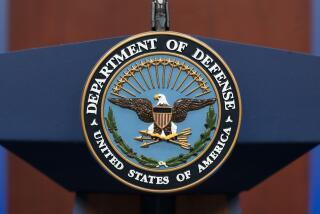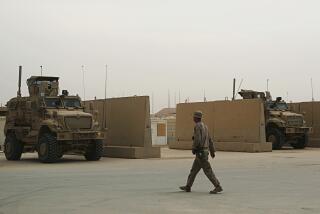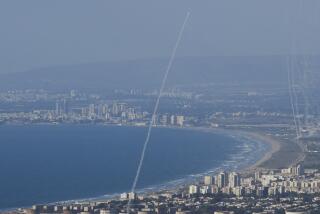In policy shift, U.S. will send commandos into Syria to advise rebels

A view of the Syrian town of Safireh, where Islamic State forces are thought to be operating, on Oct. 28.
Reporting from Washington — Facing mounting criticism for its policy in Syria, the White House said Friday it will send several dozen U.S. special operations troops to assist rebels in Syria for the first time and that it is boosting other aid to regional allies in an effort to break the military stalemate against Islamic State.
The U.S. commandos will deploy in Kurdish-controlled northeast Syria, far from the more hotly contested areas farther south and west where Russian warplanes and Iranian-backed forces are supporting a ground offensive by troops loyal to Syrian President Bashar Assad in the country’s bitter civil war.
The Americans — fewer than 50 in all — will serve as advisors to vetted Syrian and Kurdish rebel groups, help facilitate coalition airstrikes and gather intelligence on Islamic State and its allies, including an Al Qaeda-linked militia. The Americans will not take part in ground combat, officials said.
The modest operation was one of several Pentagon moves that represent a limited escalation for the Obama administration, which aims to avoid getting mired in the Syrian war and is wary of providing a recruiting tool for Islamic State propagandists.
Officials disclosed the plans Friday as Secretary of State John F. Kerry met diplomats from Russia, Iran, Saudi Arabia and more than a dozen other nations in Vienna to try to orchestrate an end to the widening conflict. The diplomats agreed to urge the United Nations to try to arrange a cease-fire but acknowledged that no breakthrough appeared likely.
Aides said President Obama made the decision Thursday to expand the U.S. military role after weeks of deliberations with his top advisors. They described growing White House frustration at the impasse in Iraq and Syria despite more than 7,750 airstrikes by coalition warplanes in the last 15 months.
Obama also approved adding about a dozen A-10 attack aircraft and an equal number of F-15 fighter jets to Incirlik Air Base in Turkey, which has faced an onslaught of militant attacks near its porous southern border. Obama will visit Turkey on Nov. 15 for the G-20 summit.
The administration also has approved increasing aid to Lebanon and Jordan, two of Syria’s other neighbors. Both have been inundated by refugees fleeing the war and fear a spillover of the fighting.
The president rejected other, more aggressive options prepared as part of a major policy review that began in the summer.
He did not authorize embedding U.S. advisors at the brigade level in Iraq, for example, or sending another squadron of Apache attack helicopters to Baghdad, as some experts had urged.
He also did not approve a Pentagon plan to impose a no-fly zone over Syria to protect civilians from attack by Assad’s forces, or a separate plan to set up a humanitarian corridor or other safe zone for displaced families.
Officials said a no-fly zone could put U.S. warplanes in direct conflict with Russian aircraft, which began bombing in Syria on Sept. 30. It also would require destroying Syria’s integrated air defense system and diverting U.S. aircraft from attacking Islamic State.
The officials said enforcing a safe zone for displaced families in northern Syria would require a major deployment of U.S. ground troops, backed by air power, to house, feed and protect them from attack.
Secretary of Defense Ashton Carter told the Senate Armed Services committee Tuesday that he had not recommended either option to Obama. “I don’t rule that out in the future,” he said.
Officials said Friday that a key goal of the current plan is to help rebels cut supply lines and communications between Raqqah, Islamic State’s administrative capital in Syria, and Mosul, its self-declared capital in Iraq, and ultimately push the militants out of both cities. They said coalition aircraft will intensify attacks in coming weeks.
The Pentagon has sent 3,550 military advisors and trainers to Iraq since August 2014 but none — at least publicly acknowledged — to Syria until now.
A Pentagon program to build a Syrian proxy force was largely abandoned last month amid reports indicating that most of the fighters trained outside the country surrendered, scattered or were killed as soon as they returned. Only 125 fighters — not the 5,400 originally intended — were trained.
White House aides said Friday that the introduction of U.S. forces into Syria does not signal a new U.S. strategy.
White House Press Secretary Josh Earnest said the small force will “further intensify the elements of our strategy that are showing progress.” He described the U.S. teams as an “important force multiplier” for the rebels.
Analysts tended to agree, saying U.S. special operators near the front lines can help organize raids and facilitate air strikes.
“You don’t need a lot of special operators to make a difference,” said Anthony Cordesman, a former intelligence director at the Pentagon now with the Center for Strategic and International Studies, a Washington think tank.
“It is a very small start, but it is headed in the right direction,” said Michael E. O’Hanlon, a military analyst at the nonpartisan Brookings Institution. It crosses “a symbolic threshold that we needed to be willing to cross.”
Critics, including Republican lawmakers, were less charitable.
Rep. Mac Thornberry (R-Texas), chairman of the House Armed Services Committee, said the escalation was “long overdue.”
“Absent a larger coherent strategy, however, these steps may prove to be too little too late,” he added. “I do not see a strategy for success.”
“This latest U.S. policy is a continuation of the extend-and-pretend policy,” said Christopher Harmer, an analyst at the Institute for the Study of War, a nonprofit public policy group in Washington. “We continue to fiddle around the margins.”
The policy shift got its start when Obama visited the Pentagon on July 6 and asked for fresh ideas to push the militants out of their strongholds in Iraq and Syria, cut off their financing sources and put them on the defensive.
Senior defense officials said they were not given any restrictions in preparing their plans.
Pentagon officials soon submitted a menu of options to the White House, aides say, and National Security Council members and staffers began studying them.
They coalesced behind a proposal to deploy special operations forces to northeast Syria, but at a low enough level that Obama could maintain his ban on sending ground troops to the war.
Officials said fewer than 50 special operators will enter northern Syria in the next week or so to meet rebel Kurds, Turkmen and Syrian Arabs to assess local security. They will stay about two months.
“This is a start to gauge what’s possible and in the meantime help them with operational planning, tactics, logistics — key elements to take and hold territory,” said a senior defense official, who briefed reporters on condition of anonymity. “The whole point of this exercise is to get on the ground, see what’s there, see what we can work with, and then move out.”
The administration has not ruled out that the Americans may one day join the rebels in ground operations, but the mission is to “start small” and build a force that can “clear, hold and build” in areas now controlled by Islamic State, the official said.
More to Read
Sign up for Essential California
The most important California stories and recommendations in your inbox every morning.
You may occasionally receive promotional content from the Los Angeles Times.












